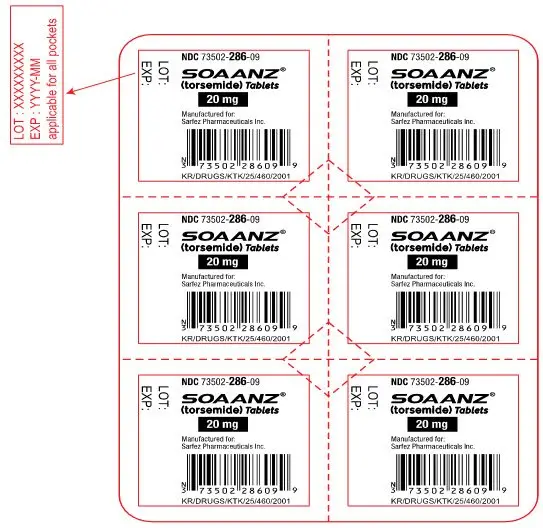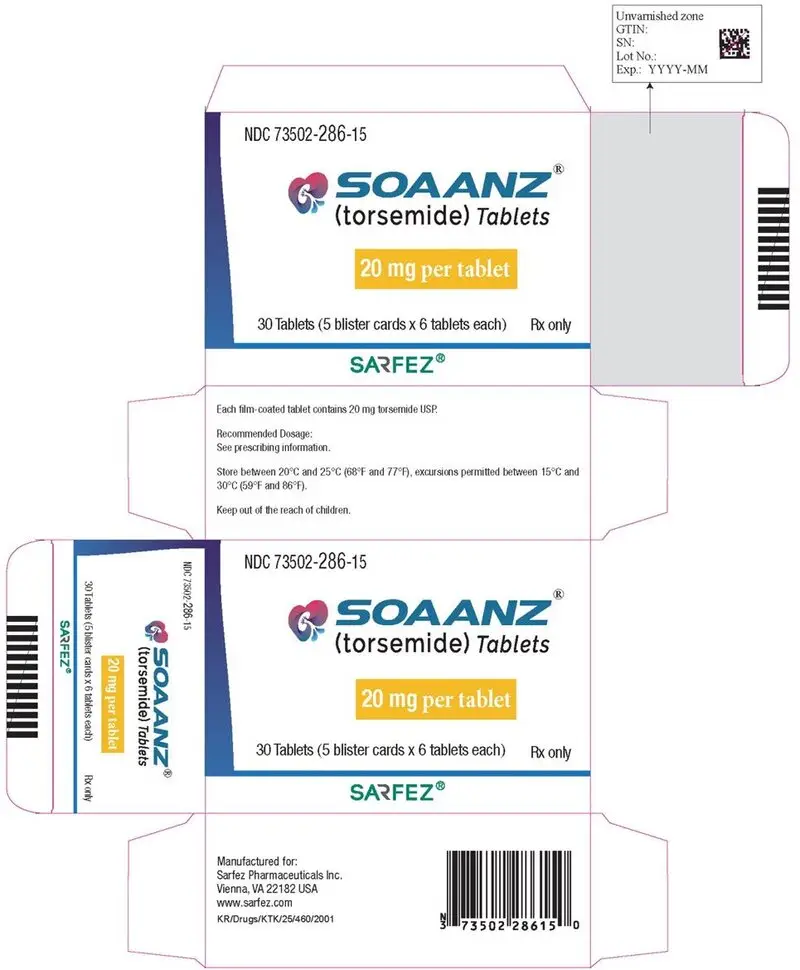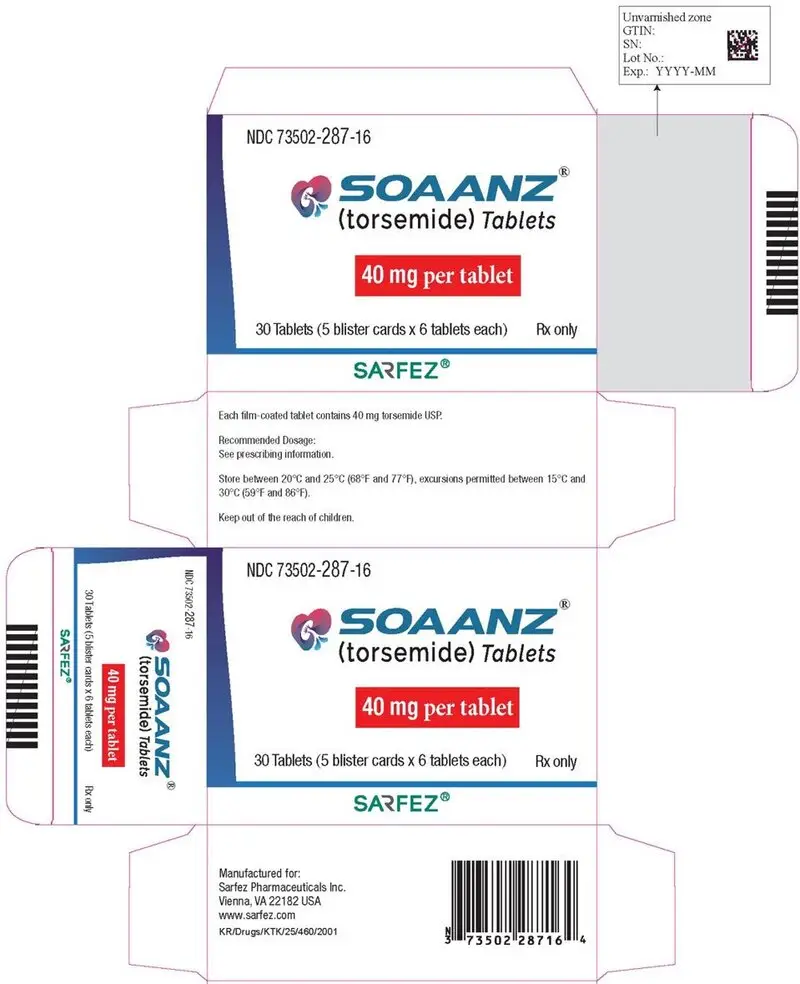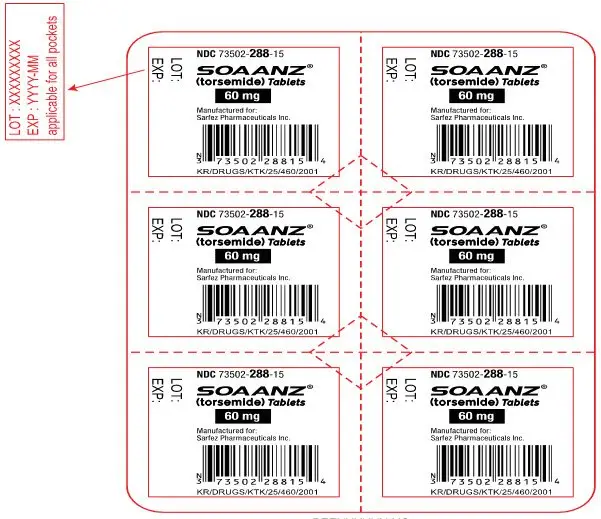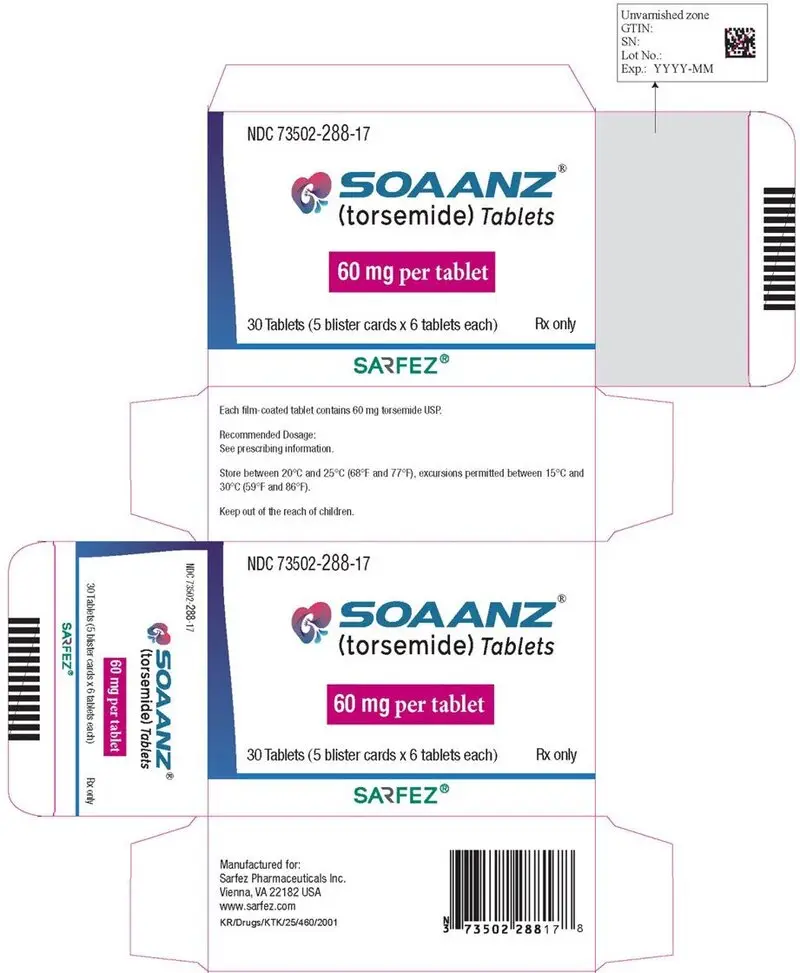Drug Detail:Soaanz (Torsemide (oral/injection) [ tor-se-mide ])
Drug Class: Loop diuretics
Highlights of Prescribing Information
SOAANZ (torsemide) tablets, for oral use
Initial U.S. Approval: 1993
Indications and Usage for Soaanz
SOAANZ is a loop diuretic indicated in adults for the treatment of edema associated with heart failure or renal disease. (1)
Soaanz Dosage and Administration
The recommended initial dose is 20 mg orally once daily. Titrate dose by approximately doubling until desired diuretic response is obtained. Doses above 200 mg have not been studied.(2)
Dosage Forms and Strengths
Tablets: 20 mg, 40 mg and 60 mg (3)
Contraindications
Hypersensitivity to SOAANZ, anuria, and hepatic coma. (4)
Warnings and Precautions
- Hypotension and worsening renal function: monitor volume status and renal function periodically (5.1)
- Electrolyte and metabolic abnormalities: monitor serum electrolytes and blood glucose periodically. (5.2)
- Ototoxicity (5.3, 7.6)
Adverse Reactions/Side Effects
Discontinuation of therapy due to adverse reactions occurred in 6% of patients treated with SOAANZ (6.1).
To report SUSPECTED ADVERSE REACTIONS, contact Sarfez Pharmaceuticals Inc. at 1-703-627-1934 or FDA at 1-800-FDA-1088 or www.fda.gov/medwatch.
Drug Interactions
- Non-steroidal anti-inflammatory drugs (NSAIDs): Reduced diuretic, natriuretic, and antihypertensive effects; risk of renal impairment. (7.1)
- CYP2C9: Concomitant use with CYP2C9 inhibitors can decrease torsemide clearance. Torsemide may affect the efficacy and safety of sensitive CYP2C9 substrates or of substrates with a narrow therapeutic range, such as warfarin or phenytoin. (7.2)
- Cholestyramine: Decreased exposure of SOAANZ. (7.3)
- Organic anion drugs: may decrease diuretic activity of SOAANZ. (7.4)
- Lithium: Risk of lithium toxicity. (7.5)
- Renin-angiotensin inhibitors: Increased risk of hypotension and renal impairment. (7.7)
- Radiocontrast agents: Increased risk of renal toxicity. (7.8)
- Corticosteroids and ACTH: Increased risk of hypokalemia. (7.9)
See 17 for PATIENT COUNSELING INFORMATION.
Revised: 12/2021
Related/similar drugs
lisinopril, metoprolol, furosemide, carvedilol, hydrochlorothiazide, spironolactone, diltiazemFull Prescribing Information
1. Indications and Usage for Soaanz
SOAANZ is indicated in adults for the treatment of edema associated with heart failure or renal disease.
2. Soaanz Dosage and Administration
The recommended initial dose is 20 mg oral SOAANZ once daily. If the diuretic response is inadequate, titrate upward by approximately doubling until the desired diuretic response is obtained. Doses higher than 200 mg have not been adequately studied.
4. Contraindications
SOAANZ is contraindicated in patients with known hypersensitivity to SOAANZ.
SOAANZ is contraindicated in patients who are anuric.
SOAANZ is contraindicated in patients with hepatic coma.
5. Warnings and Precautions
5.1 Hypotension and Worsening Renal Function
Excessive diuresis may cause potentially symptomatic dehydration, blood volume reduction and hypotension and worsening renal function, including acute renal failure particularly in salt-depleted patients or those taking renin-angiotensin aldosterone inhibitors. Worsening of renal function can also occur with concomitant use of nephrotoxic drugs. Monitor volume status and renal function periodically.
5.2 Electrolyte and Metabolic Abnormalities
SOAANZ can cause potentially symptomatic hypokalemia, hyponatremia, hypomagnesemia, hypocalcemia, and hypochloremic alkalosis. Treatment with SOAANZ can cause an increase in blood glucose levels and hyperglycemia. Asymptomatic hyperuricemia can occur, and gout may rarely be precipitated. Monitor serum electrolytes and blood glucose periodically.
6. Adverse Reactions/Side Effects
The following risks are discussed in more detail in other sections:
- Hypotension and Worsening Renal Function [see Warnings and Precautions (5.1)]
- Electrolyte and Metabolic Abnormalities [see Warnings and Precautions (5.2)]
- Ototoxicity [see Warnings and Precautions (5.3)]
6.1 Clinical Trials Experience
Because clinical trials are conducted under widely varying conditions, adverse reaction rates observed in the clinical trials of a drug cannot be directly compared to rates in the clinical trials of another drug and may not reflect the rates observed in practice.
In pre-approval studies, SOAANZ has been evaluated for safety in 65 subjects. Discontinuation of therapy due to adverse reactions occurred in 4 out of the 65 of subjects (6%) treated with SOAANZ.
6.2 Postmarketing Experience
The following adverse reactions have been identified during the post-approval use of torsemide. Because these reactions are reported voluntarily from a population of uncertain size, it is not always possible to estimate their frequency reliably or establish a causal relationship to drug exposure.
Gastrointestinal System: Pancreatitis, abdominal pain
Nervous System: Paresthesia, confusion, visual impairment, loss of appetite
Hematologic: Leucopenia, thrombocytopenia, anemia
Hepatobiliary: Increase in liver transaminases, gamma-glutamyltransferase
Metabolism: Thiamine (vitamin B1) deficiency
Skin/hypersensitivity: Stevens-Johnson syndrome, toxic epidermal necrolysis, photosensitivity reaction, pruritus
Urogenital: Acute urinary retention
7. Drug Interactions
7.1 Nonsteroidal Anti-inflammatory Drugs
Because torsemide and salicylates compete for secretion by renal tubules, patients receiving high doses of salicylates may experience salicylate toxicity when SOAANZ is concomitantly administered.
Concomitant use of nonsteroidal anti-inflammatory drugs (NSAIDs) and torsemide has been associated with the development of acute renal failure. The diuretic effects of torsemide can be reduced by NSAIDs.
Partial inhibition of the natriuretic effect of torsemide by concomitant administration of indomethacin has been demonstrated for torsemide under conditions of dietary sodium restriction (50 mEq/day) but not in the presence of normal sodium intake (150 mEq/day).
7.2 Cytochrome P450 2C9 Inhibitors and Inducers
Torsemide is a substrate of CYP2C9. Concomitant use of CYP2C9 inhibitors (e.g., amiodarone, fluconazole, miconazole, oxandrolone) can decrease torsemide clearance and increase torsemide plasma concentrations. Concomitant use of CYP2C9 inducers (e.g., rifampin) increase torsemide clearance and decrease plasma torsemide concentrations. Monitor diuretic effect and blood pressure when used in combination with CYP2C9 inhibitor or inducer. Adjust SOAANZ dose, if necessary.
Because of its inhibition of CYP2C9 metabolism, torsemide may affect the efficacy and safety of sensitive CYP2C9 substrates, such as celecoxib, or of substrates with a narrow therapeutic range, such as warfarin or phenytoin. Monitor patients and adjust dosages if necessary.
7.3 Cholestyramine
Concomitant use of torsemide and cholestyramine has not been studied in humans but, in a study in animals, coadministration of cholestyramine decreased the absorption of orally administered torsemide.
If SOAANZ and cholestyramine should be coadministered, administer SOAANZ at least one hour before or 4 to 6 h after cholestyramine administration.
7.4 Organic Anion Drugs
Coadministration of organic anion drugs (e.g., probenecid) that undergo significant renal tubular secretion have the potential to reduce secretion of torsemide into the proximal tubule which thereby decreases the diuretic activity of SOAANZ. Monitor diuretic effect and blood pressure during coadministration.
7.5 Lithium
Like other diuretics, torsemide reduces the renal clearance of lithium, inducing a high risk of lithium toxicity. Monitor lithium levels periodically when SOAANZ is coadministered.
7.6 Ototoxic Drugs
Loop diuretics increase the ototoxic potential of other ototoxic drugs, including aminoglycoside antibiotics and ethacrynic acid. This effect has been reported with concomitant use of torsemide and gentamycin. Avoid concomitant use of SOAANZ and aminoglycoside antibiotics, if possible.
7.7 Renin-angiotensin Inhibitors
Coadministration of SOAANZ with ACE inhibitors or angiotensin receptor blockers can increase the risk of hypotension and renal impairment.
8. Use In Specific Populations
8.4 Pediatric Use
The safety and effectiveness of SOAANZ in pediatric patients have not been established.
Administration of a loop diuretic to premature infants has been associated with the precipitation of nephrocalcinosis/nephrolithiasis. Nephrocalcinosis/nephrolithiasis has also been observed in children under 4 years of age with no history of prematurity who have been treated chronically with a loop diuretic. A loop diuretic, when administered during the first weeks of life, has also been reported to increase the risk of persistent patent ductus arteriosus.
8.5 Geriatric Use
Of the total number of patients who received torsemide in United States clinical studies, 24% were 65 or older and about 4% were 75 or older. No specific age-related differences in effectiveness or safety were observed between younger patients and elderly patients.
8.6 Use in Renal Impairment
In patients with non-anuric renal failure, high doses of torsemide (20 mg to 200 mg) caused marked increases in water and sodium excretion. In patients with non-anuric renal failure, severe enough to require hemodialysis, chronic treatment with up to 200 mg of daily torsemide has not been shown to change steady-state fluid retention. When patients in a study of acute renal failure received total daily doses of 520 mg to 1200 mg of torsemide, 19% experienced seizures. Ninety-six patients were treated in this study; 6/32 treated with torsemide experienced seizures, 6/32 treated with comparably high doses of furosemide experienced seizures, and 1/32 treated with placebo experienced a seizure. [see Dosage and Administration (2.1)].
10. Overdosage
The signs and symptoms of overdosage can be anticipated to include those of excessive pharmacologic effect: dehydration, hypovolemia, hypotension, hyponatremia, hypokalemia, hypochloremic alkalosis, and hemoconcentration. Treatment of overdosage should consist of fluid and electrolyte replacement.
Laboratory determinations of serum levels of torsemide and its metabolites are not widely available.
No data are available to suggest physiological maneuvers (e.g., maneuvers to change the pH of the urine) that might accelerate elimination of torsemide and its metabolites. Torsemide is not dialyzable, so hemodialysis will not accelerate elimination.
11. Soaanz Description
SOAANZ contains torsemide, a diuretic of the pyridine-sulfonylurea class. Its chemical name is 1-isopropyl-3-[(4-m-toluidino-3-pyridyl) sulfonyl] urea and its structural formula is:
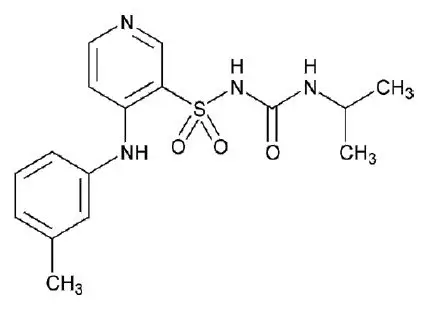
Its empirical formula is C16H20N4O3S, its pKa is 6.42, and its molecular weight is 348.42.
Torsemide is a white to off-white crystalline powder. The tablets for oral administration also contain colloidal silicon dioxide, hypromellose, iron oxide yellow, iron oxide red, lactose, magnesium stearate, microcrystalline cellulose, talc, polyethylene glycol and titanium dioxide.
12. Soaanz - Clinical Pharmacology
12.1 Mechanism of Action
Micropuncture studies in animals have shown that torsemide acts from within the lumen of the thick ascending portion of the loop of Henle, where it inhibits the Na+/K+/2Cl--carrier system. Clinical pharmacology studies have confirmed this site of action in humans, and effects in other segments of the nephron have not been demonstrated. Diuretic activity thus correlates better with the rate of drug excretion in the urine than with the concentration in the blood.
Torsemide increases the urinary excretion of sodium, chloride, and water, but it does not significantly alter glomerular filtration rate, renal plasma flow, or acid-base balance.
12.2 Pharmacodynamics
With oral dosing of SOAANZ, the onset of diuresis occurs within 1 hour and the peak effect occurs during the first four hours and diuresis lasts about 6 to 8 hours.The mean increase in potassium excretion over 23 hours following a single oral dose of SOAANZ 20 mg in healthy adults was 12.7 mEq.
12.3 Pharmacokinetics
13. Nonclinical Toxicology
13.1 Carcinogenesis, Mutagenesis, Impairment of Fertility
No overall increase in tumor incidence was found when torsemide was given to rats and mice throughout their lives at doses up to 9 mg/kg/day (rats) and 32 mg/kg/day (mice). On a body-weight basis, these doses are 27 to 96 times a human dose of 20 mg; on a body-surface-area basis, they are 5 to 8 times this dose. In the rat study, the high-dose female group demonstrated renal tubular injury, interstitial inflammation, and a statistically significant increase in renal adenomas and carcinomas. The tumor incidence in this group was, however, not much higher than the incidence sometimes seen in historical controls. Similar signs of chronic non-neoplastic renal injury have been reported in high-dose animal studies of other diuretics such as furosemide and hydrochlorothiazide.
No mutagenic activity was detected in any of a variety of in vivo and in vitro tests of torsemide and its major human metabolite. The tests included the Ames test in bacteria (with and without metabolic activation), tests for chromosome aberrations and sister-chromatid exchanges in human lymphocytes, tests for various nuclear anomalies in cells found in hamster and murine bone marrow, tests for unscheduled DNA synthesis in mice and rats, and others.
In doses up to 25 mg/kg/day (75 times a human dose of 20 mg on a body-weight basis; 13 times this dose on a body-surface-area basis), torsemide had no adverse effect on the reproductive performance of male or female rats.
16. How is Soaanz supplied
SOAANZ tablets are available as round, film-coated, debossed on one side in the following configurations:
| Strength | Color | Debossing | Bottle of 30 tablets | Bottle of 90 Tablets |
|---|---|---|---|---|
| 20 mg | Yellow | T20 | NDC 73502-786-07 | NDC 73502-786-08 |
| 40 mg | Orange | T40 | NDC 73502-586-10 | NDC 73502-586-11 |
| 60 mg | Pink | T60 | NDC 73502-687-13 | NDC 73502-687-14 |
| Strength | Color | Debossing | Tablets per Card | Carton of 30 Tablets |
|---|---|---|---|---|
| 20 mg | Yellow | T20 | 6 | NDC 73502-286-09 |
| 40 mg | Orange | T40 | 6 | NDC 73502-288-15 |
| 60 mg | Pink | T60 | 6 | NDC 73502-287-12 |
| SOAANZ
torsemide tablet, film coated |
||||||||||||||||||||||
|
||||||||||||||||||||||
|
||||||||||||||||||||||
|
||||||||||||||||||||||
|
||||||||||||||||||||||
|
||||||||||||||||||||||
|
||||||||||||||||||||||
| SOAANZ
torsemide tablet, film coated |
||||||||||||||||||||||
|
||||||||||||||||||||||
|
||||||||||||||||||||||
|
||||||||||||||||||||||
|
||||||||||||||||||||||
|
||||||||||||||||||||||
|
||||||||||||||||||||||
| SOAANZ
torsemide tablet, film coated |
||||||||||||||||||||||
|
||||||||||||||||||||||
|
||||||||||||||||||||||
|
||||||||||||||||||||||
|
||||||||||||||||||||||
|
||||||||||||||||||||||
|
||||||||||||||||||||||
| SOAANZ
torsemide tablet, film coated |
||||||||||||||||||||||
|
||||||||||||||||||||||
|
||||||||||||||||||||||
|
||||||||||||||||||||||
|
||||||||||||||||||||||
|
||||||||||||||||||||||
|
||||||||||||||||||||||
| SOAANZ
torsemide tablet, film coated |
||||||||||||||||||||||
|
||||||||||||||||||||||
|
||||||||||||||||||||||
|
||||||||||||||||||||||
|
||||||||||||||||||||||
|
||||||||||||||||||||||
|
||||||||||||||||||||||
| SOAANZ
torsemide tablet, film coated |
||||||||||||||||||||||
|
||||||||||||||||||||||
|
||||||||||||||||||||||
|
||||||||||||||||||||||
|
||||||||||||||||||||||
|
||||||||||||||||||||||
|
||||||||||||||||||||||
| Labeler - Sarfez Pharmaceuticals Inc (047963902) |










